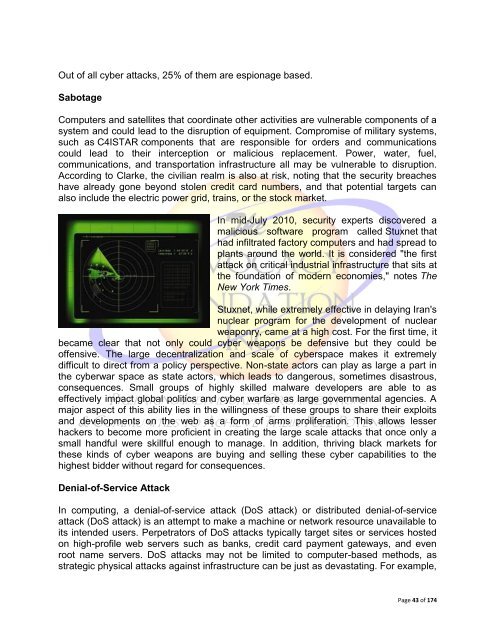International Cyber Terrorism
International Cyber Terrorism
International Cyber Terrorism
- No tags were found...
You also want an ePaper? Increase the reach of your titles
YUMPU automatically turns print PDFs into web optimized ePapers that Google loves.
Out of all cyber attacks, 25% of them are espionage based.<br />
Sabotage<br />
Computers and satellites that coordinate other activities are vulnerable components of a<br />
system and could lead to the disruption of equipment. Compromise of military systems,<br />
such as C4ISTAR components that are responsible for orders and communications<br />
could lead to their interception or malicious replacement. Power, water, fuel,<br />
communications, and transportation infrastructure all may be vulnerable to disruption.<br />
According to Clarke, the civilian realm is also at risk, noting that the security breaches<br />
have already gone beyond stolen credit card numbers, and that potential targets can<br />
also include the electric power grid, trains, or the stock market.<br />
In mid-July 2010, security experts discovered a<br />
malicious software program called Stuxnet that<br />
had infiltrated factory computers and had spread to<br />
plants around the world. It is considered "the first<br />
attack on critical industrial infrastructure that sits at<br />
the foundation of modern economies," notes The<br />
New York Times.<br />
Stuxnet, while extremely effective in delaying Iran's<br />
nuclear program for the development of nuclear<br />
weaponry, came at a high cost. For the first time, it<br />
became clear that not only could cyber weapons be defensive but they could be<br />
offensive. The large decentralization and scale of cyberspace makes it extremely<br />
difficult to direct from a policy perspective. Non-state actors can play as large a part in<br />
the cyberwar space as state actors, which leads to dangerous, sometimes disastrous,<br />
consequences. Small groups of highly skilled malware developers are able to as<br />
effectively impact global politics and cyber warfare as large governmental agencies. A<br />
major aspect of this ability lies in the willingness of these groups to share their exploits<br />
and developments on the web as a form of arms proliferation. This allows lesser<br />
hackers to become more proficient in creating the large scale attacks that once only a<br />
small handful were skillful enough to manage. In addition, thriving black markets for<br />
these kinds of cyber weapons are buying and selling these cyber capabilities to the<br />
highest bidder without regard for consequences.<br />
Denial-of-Service Attack<br />
In computing, a denial-of-service attack (DoS attack) or distributed denial-of-service<br />
attack (DoS attack) is an attempt to make a machine or network resource unavailable to<br />
its intended users. Perpetrators of DoS attacks typically target sites or services hosted<br />
on high-profile web servers such as banks, credit card payment gateways, and even<br />
root name servers. DoS attacks may not be limited to computer-based methods, as<br />
strategic physical attacks against infrastructure can be just as devastating. For example,<br />
Page 43 of 174
















